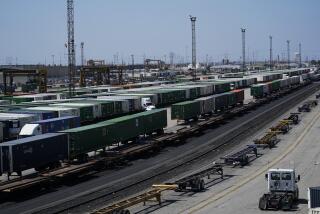Railroad Told to Get Back on Track
- Share via
Responding to a series of recent accidents and near misses involving Union Pacific trains in California -- including two this month when freight cars almost crashed into Metrolink trains in Los Angeles -- state officials criticized the Omaha-based railroad Thursday and called on it to improve its safety practices.
“We do not ... appreciate trains in our rivers, our backyards or running uncontrolled through our neighborhoods, our intersections and past our schools,” Richard Clark, director of rail safety for the Public Utilities Commission, said as he addressed the PUC board at the commission’s monthly meeting in San Francisco.
On June 20, a Union Pacific train broke loose at a rail yard in Montclair and traveled out of control for about 30 miles at speeds greater than 80 mph before derailing in a Commerce neighborhood. Nobody was killed, although the crashing train and cargo crushed several houses.
Since then, Clark said, Union Pacific trains have been involved in five more serious incidents in California.
The PUC is so concerned about Union Pacific’s performance in California that Clark and PUC board President Michael Peavey held an emergency telephone meeting last week with the head of the Federal Railroad Administration and Union Pacific’s operations director.
During the phone call, Clark said, he and Peavey told Union Pacific that the commission would step up its monitoring of the company’s tracks and trains in California, and that Union Pacific should do more to prevent accidents or near misses.
Clark said he wants Union Pacific to increase its testing of train operators and workers to ensure that they are staying alert and know all the safety rules.
The federal government, not the state, is charged with regulating interstate commerce, but PUC officials said they would pressure the Federal Railroad Administration to penalize Union Pacific if they were not satisfied with the company’s efforts.
“It is an intolerable situation to see the behavior that is going on with UP continue,” Peavey said. “I think there is a permissive culture that tolerates cutting corners in the name of costs.”
Union Pacific spokeswoman Kathryn Blackwell said the company had stepped up its safety efforts in California since the Commerce crash.
Union Pacific is installing devices that can derail runaway trains before they leave rail yards, and the company is ratcheting up its review of operation policies, Blackwell said.
“You don’t have an accident like what we had in Commerce and ... take it lightly,” she said. “Ours has been a full-court press of safety education and follow-up.”
At Thursday’s meeting, Clark outlined a string of accidents and narrowly averted collisions involving Union Pacific trains in California since the Commerce incident.
In July, a Union Pacific train rammed into an Amtrak train in Sacramento, and six cars derailed into a river in Dunsmuir. On Sept. 7, two Union Pacific trains derailed in Riverside County.
Of most concern to the PUC were two recent incidents in Los Angeles. On the morning of Sept. 12, a Union Pacific train ran a stop signal in Chatsworth.
Clark said the half-mile-long train stopped just 1,800 feet from a Metrolink commuter train that was rightfully on the track. The Metrolink train was carrying a crew, but no passengers.
Two days earlier, an eight-car Union Pacific train carrying a 700-ton load of grain broke loose from a rail yard in Commerce about 6:30 a.m. In that case, the freight train began sliding without brakes toward a Metrolink train with more than 300 people aboard about six miles away.
The freight train stopped only after a railroad worker climbed aboard and applied hand brakes to each car. That action averted a potential disaster, Clark said, because there was a “clear path of destruction between the two” trains.
Warren Flatau, a Washington-based spokesman for the Federal Railroad Administration, said his agency was auditing Union Pacific’s operations in Los Angeles and Northern California.
Clark, of the PUC, acknowledged that the railroad is working on improving safety, but he remained skeptical.
“We are concerned about their culture,” he said. “As to what is being done to change the culture, well, that is another kettle of fish.”
More to Read
Sign up for Essential California
The most important California stories and recommendations in your inbox every morning.
You may occasionally receive promotional content from the Los Angeles Times.














